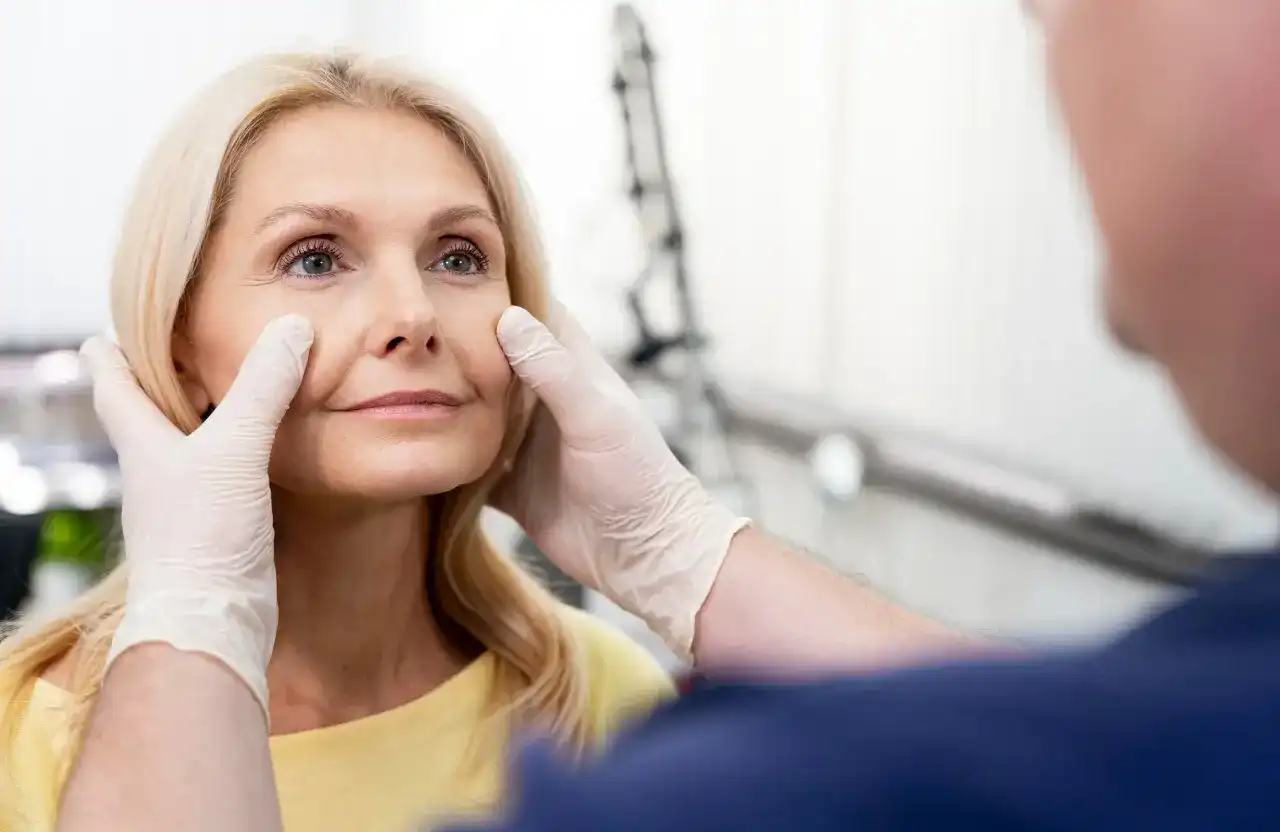
BOTOX® after Blepharoplasty: Timing BOTOX® with Eyelid Surgery
David Fuller
Last Updated On: June 23, 2024
Blepharoplasty is a popular cosmetic procedure aimed at rejuvenating the eye area.
While it effectively addresses issues like drooping eyelids and under-eye bags, resorting to BOTOX® after blepharoplasty can further enhance and prolong the youthful appearance.
This article delves into the synergy between blepharoplasty and BOTOX®, focusing on the optimal timing for injections post-eyelid surgery for optimal results.
Understanding Blepharoplasty
Blepharoplasty, more commonly known as eyelid surgery, is a sophisticated surgical procedure aimed at enhancing the appearance of the eyelids. It can be performed on the upper lids, lower lids, or both, depending on the patient’s needs.
The procedure involves the removal or repositioning of excess tissue, such as skin and fat, and the reinforcement of surrounding muscles and tendons. For the upper eyelid, the incision is typically made along the natural skin fold, making the scar virtually unnoticeable once healed. In the case of the lower eyelid, the incision is usually made just below the lashes or inside the eyelid, referred to as a transconjunctival approach.
However, this surgery is not solely for cosmetic enhancement, as it also serves a functional purpose. Drooping eyelids, a condition known as ptosis, can significantly impair vision, and blepharoplasty can effectively rectify this issue.[1]
Recovery from blepharoplasty generally takes several weeks. During this period, patients may experience swelling, bruising, irritation, or dry eyes. These symptoms are usually temporary and can be managed with medications, cold compresses, and ointments.
Is Botulinum Toxin After Blepharoplasty a Good Idea?
Integrating Botulinum toxin, commonly known as BOTOX®, post-blepharoplasty is a good idea, and most patients are extremely satisfied with the results.
As BOTOX® works by temporarily paralyzing muscles, it complements the eyelid lift achieved through blepharoplasty. This combination not only refines the rejuvenation effect but also aids in smoothing out fine lines and crow’s feet that blepharoplasty alone may not address.
Using BOTOX® for hooded eyes is a particularly good idea, as it can elevate the eyebrow margin, offering a more pronounced eyelid lift. This synergy allows for a more comprehensive approach to facial rejuvenation, targeting both structural and textural skin issues.
Timing BOTOX® with Blepharoplasty
Introducing BOTOX® before blepharoplasty is not commonly recommended, as the surgery itself may alter the landscape of the eyelid and surrounding areas. That said, there is no such thing as the optimal or precise timing for administering BOTOX® after blepharoplasty.
The key to optimal results is to allow the eyelids sufficient time to heal post-surgery before introducing BOTOX®. Typically, it is advisable to wait for at least 4 to 6 weeks after upper eyelid blepharoplasty, ensuring safety but also enhancing the overall rejuvenation effect.
Unlike the upper eyelids, the lower eyelids can have a more extended healing period, often taking up to 3 months to fully recover. This prolonged healing time is due to the delicate nature of the lower eyelid area and the complexity of the procedures often performed there, such as fat repositioning or removal.
These intervals ensure that the eyelids have adequately recovered, reducing the risk of complications and allowing for more precise BOTOX® application, which is integral for proper results.
More importantly, by timing BOTOX® appropriately after the eyelid lift, practitioners can accurately target areas that need further enhancement, such as residual fine lines or asymmetries.
Blepharoplasty or BOTOX® – Which is Better?
It’s not a matter of which is better but which is more suited to the individual’s unique needs.
For more prominent structural changes, an eyelid lift through blepharoplasty is the go-to option, whereas turning to BOTOX® for eyelids is ideal for those seeking to soften expression lines without surgery.
Nevertheless, sometimes, the most effective approach combines both, leveraging blepharoplasty’s transformative power with the finesse of BOTOX® to achieve the best look, including softening the blepharoplasty scar visibility. [2]
Conclusion
In conclusion, integrating BOTOX® after blepharoplasty can significantly enhance the rejuvenation of the eye area. While blepharoplasty corrects structural issues, BOTOX® adds a finishing touch by smoothing out fine lines, creating a harmonious and youthful look.
Timing-wise, adhering to the recommended waiting period post-surgery is crucial for eyelid lift BOTOX® safety and effectiveness, ensuring the best possible outcome from this synergistic approach to eye rejuvenation.
FAQs
Why Have BOTOX® After Blepharoplasty?
BOTOX® after blepharoplasty enhances the cosmetic results by smoothing out fine lines and wrinkles around the eyes, complementing the structural improvements of the surgery.
When to Have BOTOX® After Blepharoplasty?
It’s generally recommended to wait 4 to 6 weeks after blepharoplasty before having BOTOX® to ensure complete healing of the eyelids.
Is There A Waiting Period Recommended For Getting BOTOX® After Blepharoplasty?
Yes, a waiting period of about 4 to 6 weeks post-blepharoplasty is advised before getting BOTOX® to allow for proper healing of the eyelids.
How Long After Blepharoplasty Can Patient Wear Eye Makeup?
Typically, patients can start wearing eye makeup 2 weeks after blepharoplasty, but it’s important to confirm with your surgeon based on your individual healing process.
Do Eyelashes Fall Out After Blepharoplasty?
Eyelash loss is not a common side effect of blepharoplasty, but temporary loss of lower eyelid eyelashes can occur due to hair follicle injury.
How Long After Blepharoplasty Can a Patient Wash Their Face?
Patients can typically start washing their face gently with mild soap or a recommended cleanser 3 to 7 days after blepharoplasty, but they should avoid rubbing or applying any pressure to the treated area for the first few days.
References:
- Vaca EE, Bricker JT, Alghoul MS. Current Upper Blepharoplasty and Ptosis Management Practice Patterns Among The Aesthetic Society Members. Aesthet Surg J. 2021 Apr 12;41(5): NP198-NP209. doi: 10.1093/asj/sjaa369. PMID: 33346340.
- Yau-Li Huang, Christopher Glenn Wallace, Yen-Chang Hsiao, Mei-Ching Lee, Jung-Ju Huang, Frank Chun-Shin Chang, Zung-Chung Chen, Sindy Hu, Jyh-Ping Chen, Botulinum Toxin to Improve Lower Blepharoplasty Scar: A Double-Blinded, Randomized, Vehicle-Controlled Clinical Trial, Aesthetic Surgery Journal, Volume 41, Issue 9, September 2021, Pages 1003–1010,
Products
Cart
Log In
Newsletter
Subscribe for exclusive offers and updates on new arrivals
Share feedback at:
Working Hours
MON - SUN 9AM to 6PM EST
The Most Popular Brands
Med Supply Solutions
Support
Secure checkout is guaranteed with full adherence to PCI DSS payment standards.
Products listed here are guaranteed authentic and manufacturer-sourced.
Pay easily with trusted providers


Copyright 2025. Med Supply Solutions